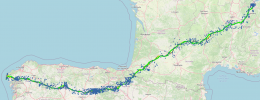I, too, found bladders kept the water cooler. I was also known for tossing a few ice cubes into it. As long as you are careful to clean out the bladder afterward, a slice of lime helped in terms of taste. I usually carried an orange as backup.
The challenge for me was not on the Frances or the del Norte, where there were plenty of fuentes or, in their absence, helpful barkeeps, but on stretches of the Primitivo or the lesser routes. As well, just because it's not warm or sunny at times, we need to keep hydrating--- even in the downpours of Galicia. I recall being inthe restaurant of the Posada in Portomarin when a Pennsylvanian pilgrim collapsed from dehydration, leaving her daughter distraught from fear that her mother had experienced a heart attack--- a waiter sprinted across the street to the residence of a doctor and brought him over, where dehydration was diagnosed and remedies provided.
But I would advise pilgrims not to drink from agricultural standpipes. I did this once, as the water looked nice and clear. I spent most of my stay in Sahagun in my hotel bathroom, repenting.

















